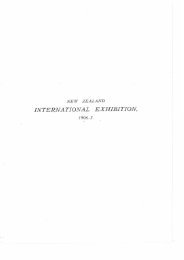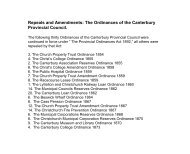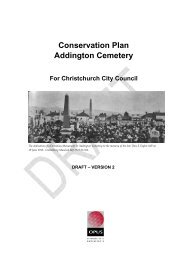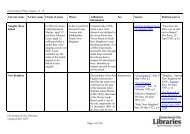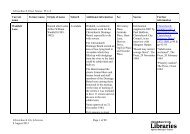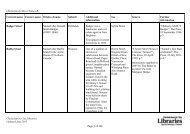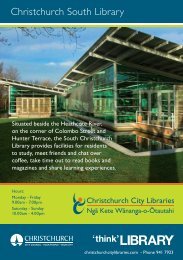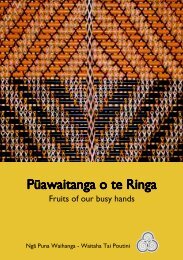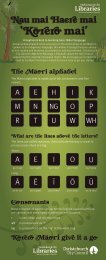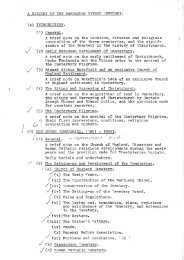Rich man, poor man, environmentalist, thief - Christchurch City ...
Rich man, poor man, environmentalist, thief - Christchurch City ...
Rich man, poor man, environmentalist, thief - Christchurch City ...
You also want an ePaper? Increase the reach of your titles
YUMPU automatically turns print PDFs into web optimized ePapers that Google loves.
‘Eventide’: photo of an 1888 John Gibb painting<br />
of the river at Burwood.<br />
Original owned by the Parochial District of<br />
Burwood<br />
12<br />
chatting with Peter Kerr. After the genial<br />
Scots<strong>man</strong>’s death in 1877, his widow, Margaret,<br />
a ‘fairly big wo<strong>man</strong> with a warm and generous<br />
heart’, carried on the tradition of hospitality.<br />
Further down, John Paynton’s tiny dwelling<br />
had a wine and beer licence. A ‘rustic... house<br />
covered with ivy’ and commonly termed the ‘Old<br />
Brown Cow’, the place had two whalebones<br />
arched as an entrance and, on either side, a holly<br />
fence. Wayfarers consumed strawberries and<br />
cream and drank wine or ‘a long draught of nut<br />
brown ale’ served ‘in a homely style’. When the<br />
licence was moved to the old Bower Hotel site,<br />
Thomas Free’s establishment continued with the strawberries<br />
and cream menu, adding whitebait teas and ‘a tot of... rum<br />
straight from the barrel and well over-proof’. The hostelry<br />
was so popular with the rowing fraternity that it survived in<br />
1894, the year that there was a general reduction in the number<br />
of liquor licences.<br />
The Dallington bridge, built in the 1880s, was testament to<br />
the abortive venture of H J C Jekyll and H P Hill to span the<br />
Avon and establish a tramway route to New Brighton. Years<br />
before, ‘Broome Farm’ had stretched from the site of<br />
McBratney’s Road back to that of the bridge. An avenue of<br />
eucalyptus led to the house from the direction of Dudley<br />
Creek, and the garden and orchard were celebrated in<br />
<strong>Christchurch</strong>. At ‘Broome Farm’ dwelt Avonside Anglican<br />
stalwarts Ellen and John Dudley, the latter ‘a fine specimen<br />
of the old colonist who brought out his family, library, plate<br />
etc’. After John’s death in 1861, Ellen married schoolteacher<br />
William De Troy, and, to the boating fraternity, the place<br />
became ‘De Troy’s’. The family welcomed all oarsmen, the<br />
ladies tipping a bucket of cherries into each boat and giving a<br />
send-off ‘so charming that De Troy’s was a delightful break –<br />
one of <strong>man</strong>y – that enhanced the trip down’. In June 1867,<br />
Ellen’s daughter, Emily Maria Dudley, a young wo<strong>man</strong> whose<br />
‘face and figure were well known on the Avon’, married grim<br />
North Island soldier-magistrate Reginald Newton Biggs.<br />
Seventeen months later the couple and their infant son were<br />
killed by the ‘dusky fiend’, Te Kooti, in a pre-emptive strike<br />
at Matawhero near Gisborne. William De Troy eventually<br />
became clerk to the Ashley Road Board. He, his wife and<br />
their daughter, Lucy, died ‘under particularly sad<br />
circumstances’ but of natural causes within a few weeks of<br />
one another, in 1894.<br />
However, always, when the boating veterans reached the<br />
spot near Kerr’s, where George Vennell had lived, their minds<br />
were concentrated on his fate.<br />
George Vennell, a plough<strong>man</strong> from Whitcombe, Dorset,<br />
was five feet four inches in height, had a large head, red hair<br />
and eyebrows, low forehead, fair complexion and hazel eyes.<br />
In youth he was convicted for theft, whipped and imprisoned.<br />
On 22 October 1838, at the age of 20, he was tried at the<br />
Somerset Quarter Sessions for stealing clothing and sentenced<br />
to be transported for 15 years. His ship, the Marquis of<br />
Hastings, arrived in Tas<strong>man</strong>ia on 18 July 1839. George’s<br />
colonial crimes ranged from absconding to ‘being in a public<br />
house on Sunday’ to ‘ill-using and causing the death of a calf,<br />
the property of his master’. He was incarcerated, put in a<br />
hard labour gang and subject to solitary confinement.<br />
On 28 August 1854, in the District of Morven, George<br />
Vennell married Mary Scollan. The groom, claiming to be<br />
33, was in fact a little older; Mary was 22. More than a decade<br />
later, the couple moved to <strong>Christchurch</strong>. George, clad in<br />
corduroy trousers, faded pea-jacket and black billycock hat,<br />
was by now stout, grey-haired and addicted to alcohol. Despite<br />
his fondness for drink, his contemporaries considered him<br />
‘an honest hard-working <strong>man</strong> in moderately good<br />
circumstances’. On 30 July 1871, however, George’s ‘beloved’<br />
Mary died of cancer at Haast Street, Avonside.<br />
Even while Mary lay dying, George was in contact with<br />
the wo<strong>man</strong> who would become his second wife. Maria<br />
Thompson had led a chequered career. As Maria Drake, 24,



